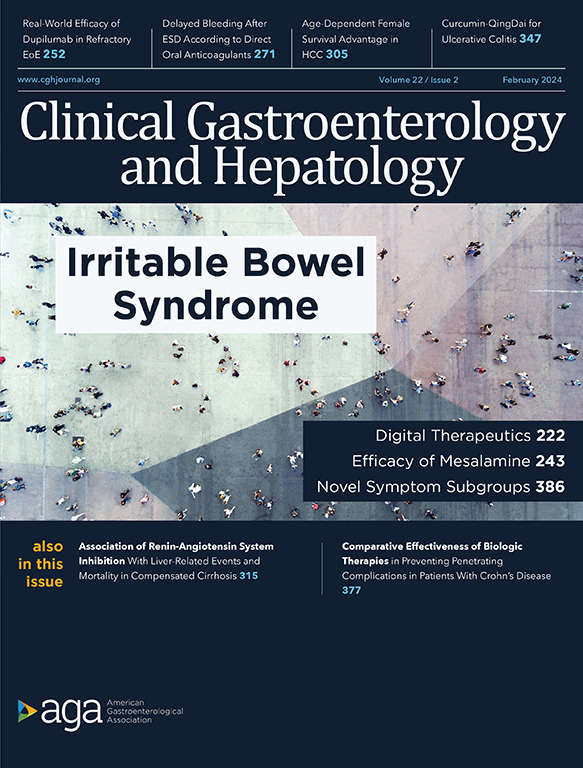Role of Early On-Treatment Serum HBV RNA Declines in Predicting Hepatocellular Carcinoma Risk in Patients With Chronic Hepatitis B
IF 11.6
1区 医学
Q1 GASTROENTEROLOGY & HEPATOLOGY
引用次数: 0
Abstract
Background and Aims
Hepatocellular carcinoma (HCC) risk prediction models established in patients with chronic hepatitis B receiving nucleos(t)ide analogue (NA) rarely include viral factors because of mediocre predictability of traditional viral markers. Here, we investigate the role of serum hepatitis B virus (HBV) RNA, a novel biomarker, in predicting HCC risk in NA-treated patients.
Methods
A total of 1374 NA-treated patients were enrolled from 2 prospective chronic hepatitis B cohorts. Serum HBV RNA was detected at baseline, year 1, 2 and 3 of treatment. Cox proportional-hazard model was used to investigate the association of HBV RNA kinetics with HCC risk.
Results
After a median follow-up of 5.4 years, 76 patients developed HCC. HBV RNA declines at year 1 (adjusted hazard ratio, 0.70; P = .009) and 2 (adjusted hazard ratio, 0.71; P = .016) were independently associated with HCC risk. Patients with less HBV RNA decline at year 1 (≤0.4 log10 copies/mL) or 2 (≤0.6 log10 copies/mL) had 2.22- and 2.09-folds higher HCC risk, respectively, than those with more declines. When incorporating these early on-treatment HBV RNA declines into existing HCC risk scores, including PAGE-B (age, sex, and platelets), modified PAGE-B (mPAGE-B) (age, sex, platelets, and albumin), and aMAP (age, sex, platelets, and albumin-bilirubin score) score, they could enhance their predictive performance (ie, C-index 0.814 vs 0.78 [model (PAGE-B + year-1 HBV RNA decline) vs PAGE-B score based on baseline parameters]).
Conclusions
Serum HBV RNA declines at year 1 and 2 were significantly associated with on-treatment HCC risk. Incorporating early on-treatment HBV RNA declines into HCC risk prediction models can be useful tools to guide appropriate surveillance strategies in NA-treated patients.

治疗早期血清 HBV RNA 下降在预测慢性乙型肝炎患者肝细胞癌风险中的作用。
背景和目的:在接受核苷类似物(NA)治疗的慢性乙型肝炎(CHB)患者中建立的肝细胞癌(HCC)风险预测模型很少包含病毒因素,因为传统病毒标志物的预测能力一般。在此,我们研究了血清乙型肝炎病毒(HBV)RNA这一新型生物标志物在预测NA治疗患者HCC风险中的作用:两个前瞻性慢性乙型肝炎队列共招募了1374名接受过NA治疗的患者。在基线、治疗第1年、第2年和第3年检测血清HBV RNA。采用 Cox 比例危险模型研究 HBV RNA 动力学与 HCC 风险的关系:中位随访 5.4 年后,76 例患者发展为 HCC。第 1 年(调整后危险比 (aHR) = 0.70,P = .009)和第 2 年(aHR = 0.71,P = .016)的 HBV RNA 下降与 HCC 风险独立相关。第 1 年(=< 0.4 log10 copies/mL)或第 2 年(=10 copies/mL)HBV RNA 下降较少的患者的 HCC 风险分别比下降较多的患者高 2.22 倍和 2.09 倍。将这些早期治疗时的 HBV RNA 下降纳入现有的 HCC 风险评分(包括 PAGE B、mPAGE B 和 aMAP 评分)时,可提高其预测性能[即 C 指数,0.814 vs. 0.788(模型(PAGE B + 第 1 年 HBV RNA 下降)vs. 基于基线参数的 PAGE B 评分)]:结论:血清 HBV RNA 在第 1 年和第 2 年的下降与治疗期间的 HCC 风险显著相关。将治疗早期的 HBV RNA 下降纳入 HCC 风险预测模型可作为有用的工具,指导对接受 NA 治疗的患者采取适当的监测策略。
本文章由计算机程序翻译,如有差异,请以英文原文为准。
求助全文
约1分钟内获得全文
求助全文
来源期刊
CiteScore
16.90
自引率
4.80%
发文量
903
审稿时长
22 days
期刊介绍:
Clinical Gastroenterology and Hepatology (CGH) is dedicated to offering readers a comprehensive exploration of themes in clinical gastroenterology and hepatology. Encompassing diagnostic, endoscopic, interventional, and therapeutic advances, the journal covers areas such as cancer, inflammatory diseases, functional gastrointestinal disorders, nutrition, absorption, and secretion.
As a peer-reviewed publication, CGH features original articles and scholarly reviews, ensuring immediate relevance to the practice of gastroenterology and hepatology. Beyond peer-reviewed content, the journal includes invited key reviews and articles on endoscopy/practice-based technology, health-care policy, and practice management. Multimedia elements, including images, video abstracts, and podcasts, enhance the reader's experience. CGH remains actively engaged with its audience through updates and commentary shared via platforms such as Facebook and Twitter.

 求助内容:
求助内容: 应助结果提醒方式:
应助结果提醒方式:


